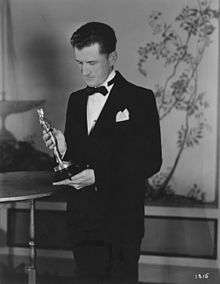Clyde De Vinna
Clyde De Vinna (born July 13, 1890 in Sedalia, Missouri, died July 26, 1953 in Los Angeles, California) was an American film and television cinematographer and director of photography. He won the Academy Award for Best Cinematography for White Shadows in the South Seas[1] presented by the Academy of Motion Picture Arts and Sciences in 1930 at its 2nd Academy Awards show.[2][3][4]
Clyde De Vinna | |
|---|---|
 | |
| Born | July 13, 1890 |
| Died | July 26, 1953 (aged 63) Los Angeles, California |
| Nationality | American |
| Other names | Clyde Da Vinna Capt. Clyde DeVinna Clyde DeVinna |
| Alma mater | University of Arkansas |
| Occupation | Cinematographer Director of photography |
| Years active | 1915–1953 |
| Organization | American Society of Cinematographers |
Notable work | White Shadows in the South Seas |
| Awards | Academy Award |
Career
De Vinna was cinematographer on over 120 film and television projects from 1916 through 1953. He graduated from the University of Arkansas and began his career began when he joined Inceville studios in 1915 as First Cameraman.[5] In 1916, he shot The Raiders, the first film to be shot at what was to become MGM.[1] He was also an avid ham radio enthusiast, serving as an army radio operator, and carrying a portable transmitter with him on all location shoots.[6] While shooting Trader Horn (1931) on location in Kenya, he seconded as the project's ham radio operator, keeping the production crew in the African bush in contact with its base camp in Nairobi.[7][8]
When on location in Alaska for 11 months for the filming of Eskimo (1933), he kept the production company in contact with its base.[6][8] While working in a small shack made air-tight against the cold, De Vinna was in short wave contact with a ham operator in New Zealand, and was overcome by carbon monoxide fumes emitted by his gasoline heater. When De Vinna's keystrokes faltered, the ham in New Zealand realized something was wrong, and put out a call for help to a ham in Hawaii, who in turn relayed the message to a ham in Alaska, which led to De Vinna receiving the necessary emergency aid.[6][8]
De Vinna's life as a cameraman, world traveler, and adventurer was captured in the 1939 Pete Smith MGM short film Radio Hams, written by Buddy Adler and directed by Felix E. Feist, with actor Alonzo Price starring as Clyde De Vinna.[9]
De Vinna was also accomplished in aerial cinematography. His scenes shot in Air Cadet (1951), were referred to as "exciting air sequences" that were the "true highlights in this routine drama".[10]
Partial filmography
- Films
- Television
- The Silver Theatre (2 episodes, 1950)
- The Roy Rogers Show (2 episodes, 1951–1952)
- I Married Joan (3 episodes, 1953)
Awards
- 1930, Won Academy Award for Best Cinematography for the film White Shadows in the South Seas (1928)[2][3][4]
References
- "Funeral Set Today for Pioneer Filmer". Sarasota Journal. July 29, 1953. p. 10. Retrieved December 5, 2010.
- Cohen, Harold W. (April 15, 1930). "Film Facts". Pittsburgh Post-Gazette. Retrieved December 5, 2010.
- Reid, John (2004). Award-Winning Films of the 1930s. p. 107. ISBN 978-1-4116-1432-1.
- Bergan, Ronald; Fuller, Graham; Malcolm, David (1994). Academy Award Winners (illustrated ed.). Prion. p. 23. ISBN 978-1-85375-147-9.
- Erickson, Hal. "Clyde De Vinna". The New York Times. Retrieved December 5, 2010.
- "Radio Operator and Cameraman". Radio News. Vol. 15. Ziff-Davis Pub. Co. 1933. p. 522.
- Bartlett, Richard A. (2007). The World of Ham Radio, 1901–1950: a social history (illustrated ed.). McFarland & Company. pp. 113–114. ISBN 978-0-7864-2966-0.
- DeSoto, Clinton B. (1941). Calling C Q: Adventures of Short-Wave Radio Operators (PDF) (First ed.). Chapter 5, A Vagabond Ham: Doubleday, Doran & company, inc. pp. 43–53.CS1 maint: location (link)
- American Radio Relay League (1939). "Radio Hams". QST. American Radio Relay League. p. 31.
- Nash, Jay Robert; Ross, Stanley Ralph (1985). The Motion Picture Guide, Volume 1. The Complete Film Resource Center Series. Cinebooks. p. 32. ISBN 978-0-933997-00-4.
- Love, Bessie (1977). From Hollywood with Love: An Autobiography of Bessie Love. London: Elm Tree Books. p. 150. OCLC 734075937.